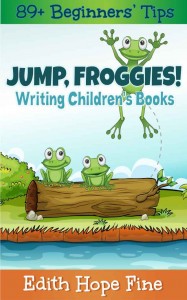So You Want to Write for Children . . .
 One of our favorite books we have worked on is Jump, Froggies! Writing Children’s Books: 89+ Beginners’ Tips by Edith Hope Fine. We asked her to blog about her book (available in print and as an ebook) because it is a treasure trove for new authors. Her years of experience in a variety of genres are shared generously so newbies can learn from a veteran. Edith Hope Fine is an award-winning children’s writer with eighteen books. She runs the published members’ group of the San Diego chapter of SCBWI (the Society of Children’s Book Writers and Illustrators), a non-profit organization that offers support to beginners and pros alike.
One of our favorite books we have worked on is Jump, Froggies! Writing Children’s Books: 89+ Beginners’ Tips by Edith Hope Fine. We asked her to blog about her book (available in print and as an ebook) because it is a treasure trove for new authors. Her years of experience in a variety of genres are shared generously so newbies can learn from a veteran. Edith Hope Fine is an award-winning children’s writer with eighteen books. She runs the published members’ group of the San Diego chapter of SCBWI (the Society of Children’s Book Writers and Illustrators), a non-profit organization that offers support to beginners and pros alike.
 How many times while reading to kids have you thought, “I could do this—I could write a children’s book”? If you love playing with words, still relish memories of books from childhood, read widely, and are open to hard work, you could be right.
How many times while reading to kids have you thought, “I could do this—I could write a children’s book”? If you love playing with words, still relish memories of books from childhood, read widely, and are open to hard work, you could be right.
Do you know the joke about the frogs? Five froggies sit on a log. One decides to jump. How many are left on the log? Five, because deciding isn’t doing.
It’s one thing to think about writing articles, stories, or books for children and quite another to do it. Accumulating the knowledge and skills you’ll need is a process.
You do need to know today’s books. If you’re aiming for the young adult (YA) market, read in that genre. Study the riveting The Maze Runner to discover how author James Dashner built a unique, surprising world where teens must unlock a secret, but the rules change every day. Tune into today’s important thrust toward diverse books so that all young readers can find themselves in books. (Check out the “We Need Diverse Books” website—the front page says it all: http://weneeddiversebooks.org/ and #weneeddiversebooks.)
Where to Start?
If you find figuring out where to start seems dizzying, take a look at my new Jump, Froggies! Writing Children’s Books: 89+ Beginners’ Tips (eBook or paperback) to take you on a step-by-step journey through the world of children’s publishing.
Here’s a quick dip into the Table of Contents—just six of the many topics covered:
• Learn from What You Read
• Your Space, Your Schedule, Your Tools
• Quick Tips: Honing Your Skills
• Revision
• THE Call—“We want your book!”
• To Market, To Market . . .
Three Beginners’ Tips: Contests, Digging In, No Art!
First, hone and polish your work, then enter contests. Lee & Low Books, known for its award-winning multicultural books, nurtures new writers. Writers of color should check out their New Voices Award and New Visions Award. (The deadline is Sept. 30 for the former, Oct. 31 for the latter.)
Second, read, read, read. Dig into the sorts of books you want to write—nonfiction? middle grade mystery? dark YA (young adult)? Study what draws you in. Check out specifics such as structure, characters, tension, foreshadowing.
Third, if you’re goal is to write a picture book, don’t send art—that’s not your job. Seriously.
Persist
You may try your hand at picture books (easier said than done) or focus on middle school humor. You may, like me, hop across age levels and try your hand at both fiction and nonfiction. There’s no one right way. The trick is finding what works for you.
You’ll take classes. You’ll practice. You’ll accumulate rejections. You’ll keep on.
One thing’s certain. If you persist, your writing will become stronger and stronger and you’ll have a real chance to make that dream of holding in your hands a children’s book with your name on the cover.
Two words, my friends: Jump, froggies!